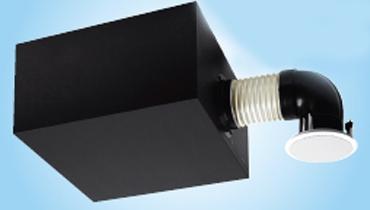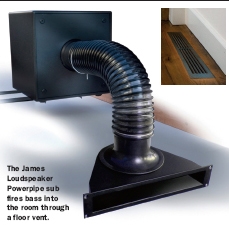7 Ways To Hide Your Subwoofer

The first "real" A/V component I ever bought was a subwoofer - a glorious 15-inch beast that made no attempt to hide what it really was: a big, black, utterly style-less cube. At the time, there weren't really any other options available, so adding a sub meant a big, black cube. My wife, possibly sensing that our future might be connected with this whole "audio" thing, tolerated the sub but never really grew to love it.
Nowadays, most people take one look at a "traditional" sub and say, "Do I have to have that?" The implication is that a "yes" will kibosh the entire system. But the subwoofer's importance has increased until it's become an almost indispensable part of any surround system. As style demands have dictated a transition to smaller and less obtrusive models, the ability of speakers to offer any bass reproduction has gone by the wayside. Beyond the impact and emotion they add to the home theater experience, subwoofers lend the weight and depth crucially missing in small speakers.
Fortunately, technological advances like new driver designs and powerful digital amplification have resulted in so many great options that you'll almost never come across a situation where a sonically and visually appealing solution can't be found. Below are a few options to consider for adding some stealthy bass to your system.
Go Small
There are tons of subwoofers not much larger than a bowling ball. Because of their size, these mighty micros offer lots of discreet placement options, like under a table, behind a plant, or behind some drapes. But don't expect these subs to be cheaper just because they're smaller. "Miniaturization and concealment come with a price," Velodyne's Joe Finn points out. "A small sub works harder and must be made of better materials, have a more powerful amp, and so on to produce the same quantity and quality of bass as a sub with plenty of cabinet volume." So you can have good and small - just don't expect cheap.
| Go In-Wall We've enjoyed in-wall speakers for 27 years, but subwoofers have only recently made the migration into the wall. Part of the problem is the technology required to make this kind of sub perform well without shaking your walls apart. Sunfire's Eric Harper commented on the importance of decoupling "the shaking force of the woofer from the wall." Sunfire's approach is to use some good old-fashioned physics - in particular, Newton's Third Law of Motion ("for every action there is an equal but opposite reaction"). |  |
|---|
"By employing a weighted antishake device that's wired out of phase with the woofers, [Sunfire's in-wall sub achieves] a five times reduction in the vibration coming from the cabinet," Eric says.
Chris Brunhaver from BG Radia, inventors of the world's first THX Ultra 2-certified in-wall subwoofer, echoes Harper's comments: "The most significant challenge is designing and installing them so as to not mechanically vibrate the surrounding structure. That sort of vibration seriously degrades quality and it colors the sound. I wouldn't consider using an in-wall subwoofer that doesn't have a specific technology to address this important issue."
Go In-Ceiling
Since bass frequencies are mostly nondirectional, the ceiling can be another great place for a hidden-sub install. This option works especially well if the other speakers are also in the ceiling since this helps to "marry" the bass information to the other channels, creating a more cohesive effect.
Go In-Floor
If your floor is a concrete slab, you should probably skip this option. But if your home is built on a crawl space or above a basement, then the floor can be a terrific location. Mount the sub between the floor joists, replace the traditional speaker grille with an HVAC register, and your guests will be wondering where all that great sound is coming from.
Go Under-Furniture
For another stealthy install, consider the suggestion from Carl Kennedy of JL Audio to position the sub "under the sofa firing straight up into the seats." The same thin models that go inside walls can also slide under some sofas. Besides the benefits of keeping the sub out of sight, this is a great install for areas where excessive bass can disturb the neighbors (like in a condo or apartment) or wake sleeping family members. Since the signal is coming from literally inches away, you can greatly lower the volume level and still get a really nice tactile response.
Go In-Cabinet
Clearing out a compartment in your cabinetry or entertainment center offers another great place to conceal a sub. Sunfire's Harper recommends a front-firing model for in-cabinetry use. "Side- and down-firing subs tend to create more cabinet rattle since they send sound waves directly into a cabinet surface."
Al Baron from Polk Audio gave the same forward-firing recommendation, and also advised, "Keep the space around the woofer enclosure to a minimum to reduce unwanted resonances from this 'secondary enclosure.' The cabinet's interior will have a resonant frequency all its own that will exaggerate this range unnecessarily, muddying up the bass. If you can't minimize the space, stuff fairly dense batting or insulation around the sides and back to reduce the level of this resonance." If you plan to hide the sub behind closed doors, make sure the doors aren't solid but rather a material like speaker-grille cloth or perforated metal to allow bass to flow into the room. If the idea of altering your cabinet doors is a turn-off, consider James Loudspeaker's Powerpipe sub, which fires bass through a tube that ports into your room through a vent in the subwoofer. Very slick.
Build A False Wall
If you like the idea of an invisible sub but need something massive like Definitive Technology's SuperCube Trinity Reference, JL Audio's Gotham, or Velodyne's DD-18, you can build a new wall in the front of the room. The speakers can sit in the space behind this wall, which can be finished with a variety of sound-friendly fabrics that let you hide all of your speakers, regardless of their size.
While hitting up manufacturers for their tips and tricks on getting the most sub out of discreet locations, it quickly became apparent that there was just too much information to cover in one column. So next month, I'm going to relay some of the terrific things I gleaned from the sub makers to help you get the best bass performance from your system regardless of the type of sub you use.
Check out our 2009 Holiday Gift Guide: Filled with 60 Products that will crank up the fidelity on your shopping list.













































